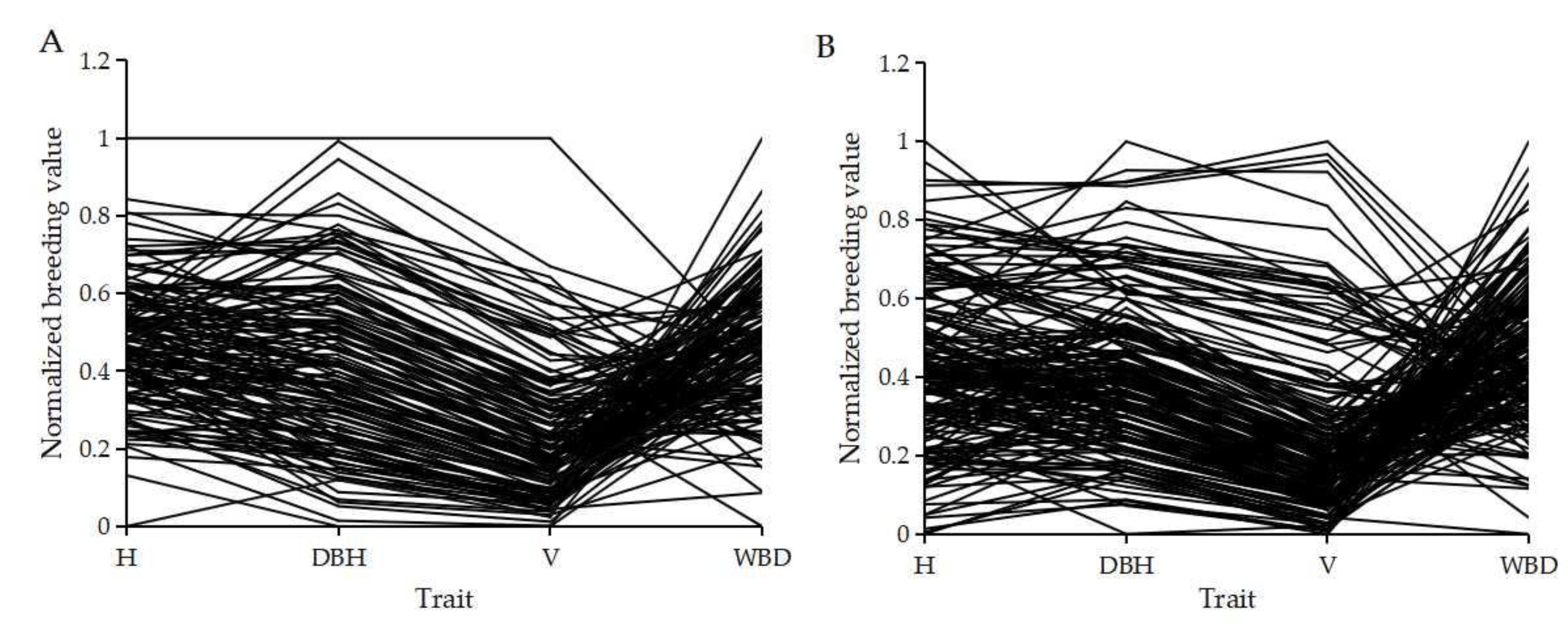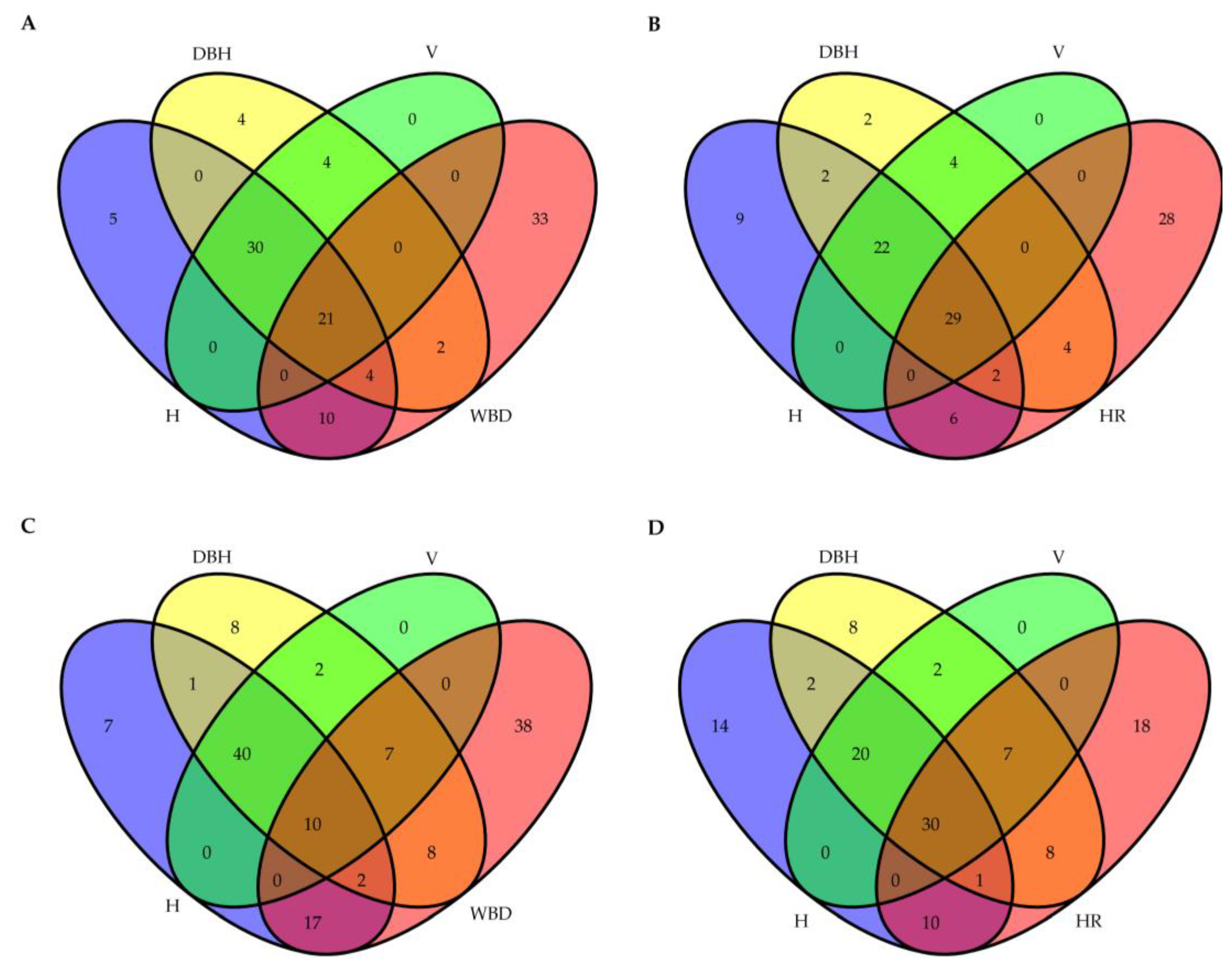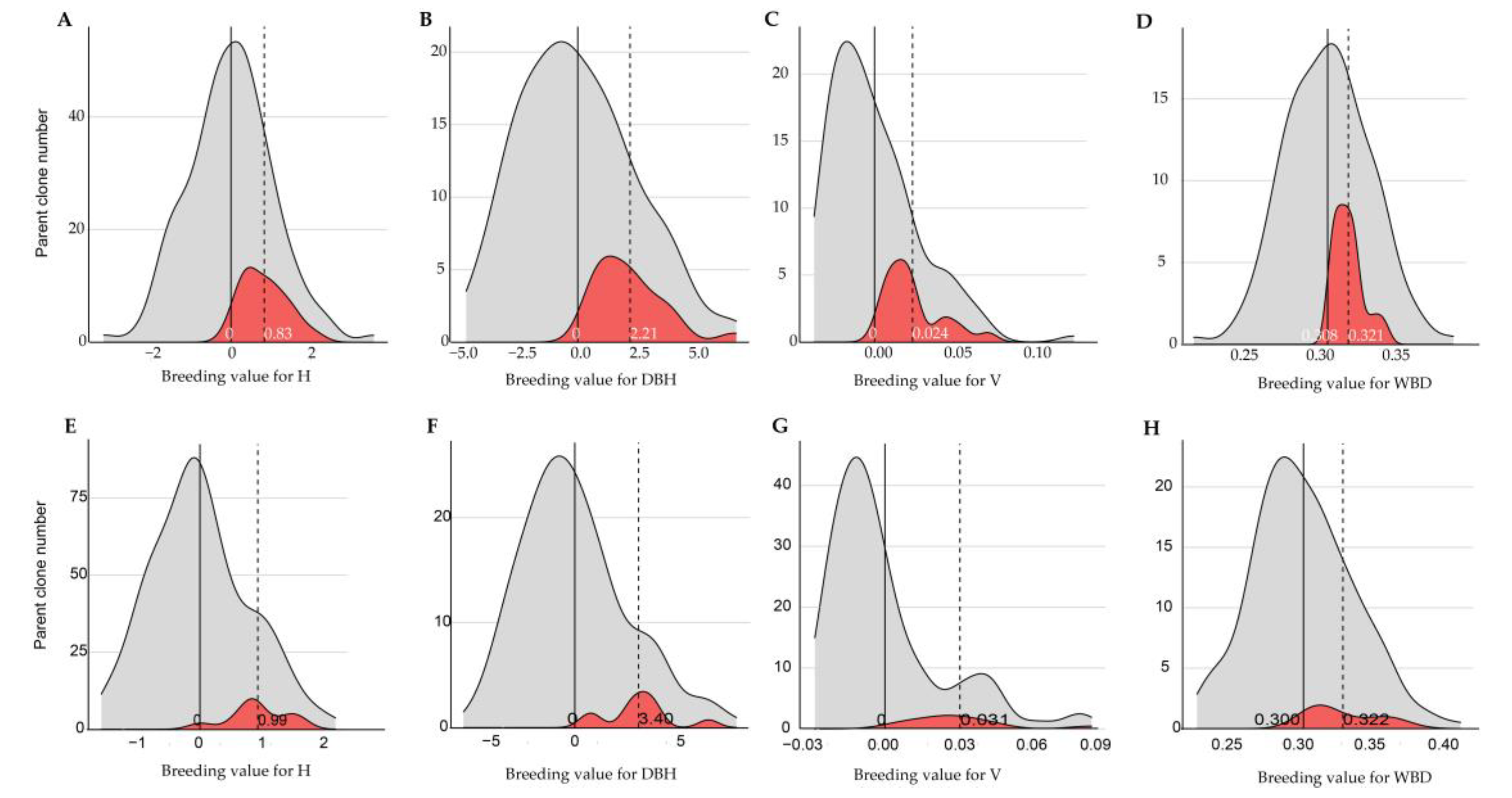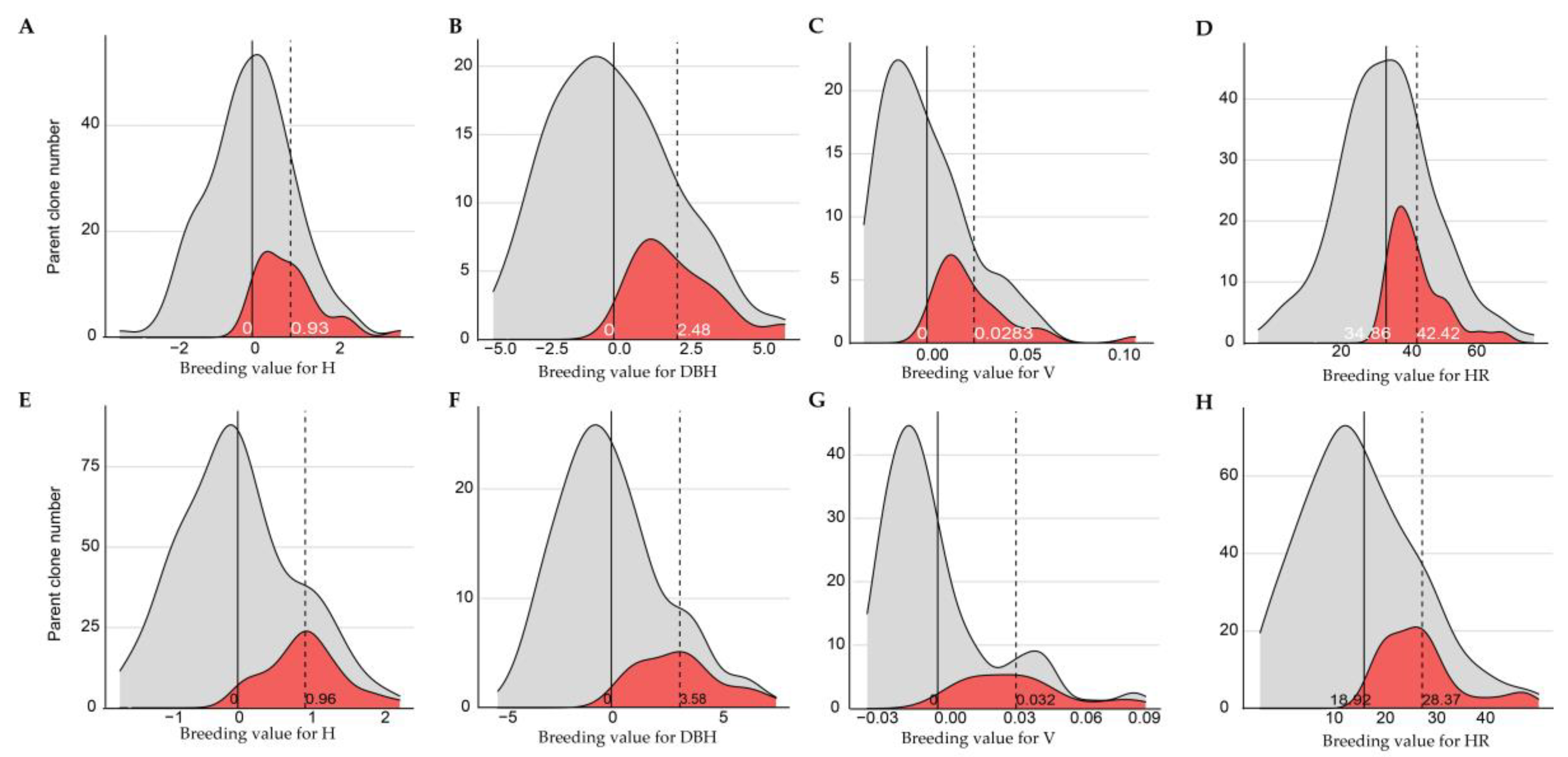Selection for Both Growth and Wood Properties in Chinese Fir Breeding Parents Based on a 6-Year Grafted Clone Test
Abstract
:1. Introduction
2. Materials and Methods
2.1. Test Locations and Materials
2.2. Phenotypic Measurements
2.3. Statistical Analysis
3. Results and Discussion
3.1. Differences among Parent Clones in Growth and Wood Property Traits
3.2. Genetic and Phenotypic Correlations among Traits
3.3. Parent Clone Selection
4. Conclusions
Supplementary Materials
Author Contributions
Funding
Data Availability Statement
Conflicts of Interest
References
- Cellon, C.; Amadeu, R.R.; Olmstead, J.W.; Mattia, M.R.; Ferrao, L.F.V.; Munoz, P.R. Estimation of genetic parameters and prediction of breeding values in an autotetraploid blueberry breeding population with extensive pedigree data. Euphytica 2018, 214, 87. [Google Scholar] [CrossRef]
- Bouvet, J.M.; Ekomono, C.G.M.; Brendel, O.; Laclau, J.P.; Bouillet, J.P.; Epron, D. Selecting for water use efficiency, wood chemical traits and biomass with genomic selection in a Eucalyptus breeding program. Forest Ecol. Manag. 2020, 465, 118092. [Google Scholar] [CrossRef]
- Blada, I.; Dinu, C.; Tănasie, Ş.; Bratu, I. Growth, straightness and survival at age 32 in a Pinus strobus x P. wallichiana F1 hybrid population (Experiment 1). Ann. For. Res. 2013, 56, 15–30. [Google Scholar]
- Viana, J.M.S.; Faria, V.R.; Fonseca e Silva, F.; de Resende, M.D.V. Best Linear Unbiased Prediction and Family Selection in Crop Species. Crop Sci. 2011, 51, 2371–2381. [Google Scholar] [CrossRef]
- Huber, D.A. Optimal Mating Designs and Optimal Techniques for Analysis of Quantitative Traits in Forest Genetics. Ph.D. Thesis, Department of Forestry, University of Florida, Gainsville, FL, USA, 1993. [Google Scholar]
- Xiang, B.; Li, B. A new mixed analytical method for genetic analysis of diallel data. Can. J. For. Res. 2001, 31, 2252–2259. [Google Scholar] [CrossRef]
- Henderson, C.R. Sire Evaluation and Genetic Trends. In The Animal Breeding and Genetics Symposium in Honor of Dr. Jay L. Lush; American Society of Animal Science: Champaign, IL, USA, 1973. [Google Scholar]
- Abdollahi-Arpanahi, R.; Lourenco, D.; Legarra, A.; Misztal, I. Dissecting genetic trends to understand breeding practices in livestock: A maternal pig line example. Genet. Sel. Evol. 2021, 53, 89. [Google Scholar] [CrossRef] [PubMed]
- Adeolu, I.A.; Ibe, S.N. Application of Best Linear Unbiased Predictor (BLUP) in estimating breeding value for rabbit bucks raised in humid tropics. Nigerian J. Anim. Sci. 2020, 22, 33–41. [Google Scholar]
- Maucourt, S.; Rousseau, A.; Fortin, F.; Robert, C.; Giovenazzo, P. Observation of genetic gain with instrumental insemination of honeybee queens. Insects 2023, 14, 301. [Google Scholar] [CrossRef]
- White, T.L.; Hodge, G.R. Best linear prediction of breeding values in a forest tree improvement program. Theor. Appl. Genet. 1988, 76, 719–727. [Google Scholar] [CrossRef]
- Rambolarimanana, T.; Ramamonjisoa, L.; Verhaegen, D.; Tsy, J.-M.L.P.; Jacquin, L.; Tuong-Vi, C.-H.; Makouanzi, G.; Bouvet, J.-M. Performance of multi-trait genomic selection for Eucalyptus robusta breeding program. Tree Genet. Genomes 2018, 14, 71. [Google Scholar] [CrossRef]
- Araujo, M.J.D.; Paula, R.C.D.; Campoe, O.C.; Carneiro, R.L. Adaptability and stability of eucalypt clones at different ages across environmental gradients in Brazil. For. Ecol. Manag. 2019, 454, 117631. [Google Scholar]
- Ingvarsson, P.K.; Garcia, M.V.; Luquez, V.; David, H.; Jansson, S. Nucleotide polymorphism and phenotypic associations within and around the phytochrome B2 Locus in European aspen (Populus tremula, Salicaceae). Genetics 2008, 4, 2217–2226. [Google Scholar] [CrossRef] [PubMed]
- Induri, B.R.; Ellis, D.R.; Slavov, G.T.; Yin, T.; Zhang, X.; Muchero, W.; Tuskan, G.A.; Difazio, S.P. Identification of quantitative trait loci and candidate genes for cadmium tolerance in Populus. Tree Physiol. 2012, 5, 626–638. [Google Scholar] [CrossRef] [PubMed]
- Dunlop, R.W.; Resende, M.D.V.; Beck, S.L. Early assessment of first year height data from five Acacia mearnsii (black wattle) sub-populations in south Africa using REML/BLUP. Silvae Genet. 2005, 54, 166–174. [Google Scholar] [CrossRef]
- Deng, L.; Huang, T.; Wang, Z.; Wu, S.; Li, X.; Liao, Y.; Li, Y.; Guo, W.; Zhao, F. Genetic analysis of clones and a new round breeding parents selection in the improved slash pine seed orchard. For. Environ. Sci. 2020, 36, 1–7. [Google Scholar]
- Lenz, P.R.N.; Nadeau, S.; Mottet, M.-J.; Perron, M.; Isabel, N.; Beaulieu, J.; Bousquet, J. Multi-trait genomic slection for weevil resistance, growth, and wood quality in Norway spruce. Evol. Appl. 2019, 13, 76–94. [Google Scholar] [CrossRef]
- Ouyang, F.; Qi, S.; Fan, G.; Cai, Q.; Chen, H.; Gao, W.; Hu, C.; Wang, J. Genetic variation and improved parents selection of open pollination families of Picea crassifolia Kom. basing one BLUP method. Nanjing For. Univ. Nat. Sci. Ed. 2019, 43, 53–59. [Google Scholar]
- Zheng, H.; Hu, D.; Wang, R.; Wei, R.; Yan, S. Assessing 62 Chinese fir (Cunninghamia lanceolata) breeding parents in a 12-year grafted clone test. Forests 2015, 6, 3799–3808. [Google Scholar] [CrossRef]
- Huang, R.; Zeng, W.; Deng, h.; Hu, D.; Wang, R.; Zheng, H. Inbreeding in Chinese fir: Insight into the rare self-fertilizing event from a genetic wiew. Genes 2022, 13, 2105. [Google Scholar] [CrossRef]
- Fung, L.E. Wood properties of New Zealand-grown Cunninghamia lanceolata. N. Z. J. For. Sci. 1993, 23, 324–338. [Google Scholar]
- Tran, B.D.; Le, T.N.H. A review of Cunninghamia lanceolata (Lamb.) Hook: A recent update and potential application in Vietnam. Vietnam. J. Agric. Sci. 2020, 3, 892–902. [Google Scholar] [CrossRef]
- Zheng, H.Q.; Duan, H.J.; Hu, D.H.; Li, Y.; Hao, Y.B. Genotypic variation of Cunninghamia lanceolata revealed by phenotypic traits and SRAP markers. Dendrobiology 2015, 74, 83–92. [Google Scholar] [CrossRef]
- Duan, H.J.; Hu, D.H.; Li, Y.; Zheng, H.Q. Characterization of a collection of Chinese fir elite genotypes using sequence-related amplified polymorphism markers. J. For. Res. 2016, 27, 1105–1110. [Google Scholar] [CrossRef]
- Wang, R.H.; Hu, D.H.; Wei, R.P.; Yan, S.; Zheng, H.Q. Early evaluation and selection of the Chinese fir breeding parents based on growth and cone production traits. Subtrop. Plant Sci. 2023, 52, 43–49. [Google Scholar] [CrossRef]
- Shalizi, M.N.; Gezan, S.A.; Mckeand, S.E.; Sherrill, J.R.; Cumbie, W.P.; Whetten, R.W.; Isik, F. Correspondence between breeding values of the same Pinus taeda L. genotypes from clonal trials and half-sib seedling progeny trials. For. Sci. 2020, 66, 600–611. [Google Scholar] [CrossRef]
- Zheng, H.Q.; Hu, D.H.; Wei, R.P.; Wang, R.H.; Cai, W.J. Fast-growing clone selection and wood quality analysis in Chinese fir. Chin. Agric. Sci. Bull. 2012, 28, 27–31. [Google Scholar]
- Zhao, Y.K.; Huang, R.F.; Lv, J.X.; Zhao, R.J.; Fei, B.H.; Yu, H.Q.; Huang, A.M.; Liu, Y.T. GB/T 1934.1–2009 Method for Determination of the Water Absorption of Wood; AQSIQ and SAC Press (China): Beijing, China, 2009. [Google Scholar]
- Cheng, J.Q. Wood Science; China Forestry Publishing House: Beijing, China, 1985. [Google Scholar]
- Xu, J.R. Quantitative Genetics in Forestry; Higher Education Press: Beijing, China, 2006. [Google Scholar]
- Gilmour, A.; Gogel, B.; Cullis, B.; Thompsom, R. ASReml User Guide, Release 3.0; VSN International Ltd.: Hemel Hempstead, UK, 2009. [Google Scholar]
- Wickham, H. Ggplot2: Elegant Graphics for Data Analysis; Springer: New York, NY, USA, 2009. [Google Scholar]
- Zhang, P.; Wu, F.; Kang, X. Genotypic variation in wood properties and growth traits of triploid hybrid clones of Populus tomentosa at three clonal trials. Tree Genetic. Genomes 2012, 8, 1041–1050. [Google Scholar] [CrossRef]
- Piepho, H.P.; Möhring, J.; Melchinger, A.E.; Büchse, A. BLUP for phenotypic selection in plant breeding and cultivars testing. Euphytica 2008, 161, 209–228. [Google Scholar] [CrossRef]
- Yang, H.; Weng, Q.; Li, F.; Zhou, C.; Li, M.; Chen, S.; Ji, H.; Gan, S. Genotypic variation and genotype-by-environment interactions in growth and wood properties in a cloned Eucalyptus urophylla × E. tereticornis family in southern China. For. Sci. 2018, 64, 225–232. [Google Scholar] [CrossRef]
- Abinasa, M.; Ayana, A.; Bultosa, G. Genetic variability, heritability and trait associations in durum wheat (Triticum turgidum L. var. durum) genotypes. Afr. J. Agr. Res. 2011, 6, 3972–3979. [Google Scholar]
- Gebrie, G.; Abebe, D.; Atnaf, M.; Wondifraw, D.; Dessie, A. An investigation of phenotypic and genotypic variations in 100 upland rice genotypes at Pawe, Northwestern Ethiopia. J. Genet. Resour. 2022, 8, 111–116. [Google Scholar] [CrossRef]
- Guerriero, G.; Sergeant, K.; Hausman, J.F. Wood biosynthesis and typologies: A molecular rhapsody. Tree Physiol. 2014, 34, 839–855. [Google Scholar] [CrossRef] [PubMed]
- Liu, X.; Lu, Z.; Wu, J.; Yang, Y.; Li, S.; Wu, L.; Xu, Q.; Yu, Q.; Zhao, L.; Sun, J.; et al. Comparison of genetic impact on growth and wood traits between seedlings and clones from the same plus trees of Pinus koraiensis. J. For. Res. 2023, 34, 469–480. [Google Scholar] [CrossRef]
- Wu, Y.; Mao, C.L. Simple introduction to heritability, repeatability and genetic gain in percent in tree breeding. Trop. Agric. Sci. Technol. 2012, 35, 47–50. [Google Scholar] [CrossRef]
- Kha, L.D.; Harwood, C.E.; Kien, N.D.; Baltunis, B.S.; Hai, N.D.; Thinh, H.H. Growth and wood basic density of acacia hybrid clones at three locations in Vietnam. New For. 2012, 43, 13–29. [Google Scholar]
- Silva, J.C.E.; Wellendorf, H.; Borralho, N.M.G. Prediction of breeding values and expected genetic gains in diameter growth, wood density and spiral grain from parental selection in Picea abies (L.) KARST. Silvae Genet. 2000, 49, 102–109. [Google Scholar]
- Hein, P.R.; Campos, A.C.; Trugilho, P.F.; Lima, J.T.; Chaix, G. Near infrared spectroscopy for estimating wood basic density in Eucalyptus urophylla and E. grandis. Cerne 2015, 15, 133–141. [Google Scholar]
- Hu, D.H.; Ruan, Z.C.; Qian, Z.N.; Huang, Y.M.; Huang, X.P.; Chen, Z.L. The genetics and variation of wood density in Chinese fir clones and its interaction to the growth characters. J. Cent. South For. Univ. 2004, 24, 24–27. [Google Scholar]
- Hu, D.H.; Hao, Y.B.; Liang, J.; Zheng, H.Q.; Wang, R.H.; Wei, R.P.; Yan, S.; Lai, X.E.; Lin, J.; Liang, Q. Variation analysis on growth and wood quality traits of Cunninghamia lanceolata clones in Lechang germplasm bank. J. Southwest For. Univ. 2011, 31, 1–5. [Google Scholar]
- Li, R.L.; Huang, S.X.; Liang, J.; Zhou, C.M.; He, C.H.; Li, L.M.; Tang, G.Q. Genetic variation of growth traits and wood properties in Chinese fir clones. J. South Agric. 2014, 9, 1626–1631. [Google Scholar]
- Hosseinaei, O.; Wang, S.; Enayati, A.A.; Rials, T.G. Effects of hemicellulose extraction on properties of wood flour and wood–plastic composites. Compos. Part A Appl. Sci. Manuf. 2012, 43, 686–694. [Google Scholar] [CrossRef]
- Sun, S.; Zhao, Z.; Umemura, K. Further exploration of sucrose-citric acid adhesive: Synthesis and application on plywood. Polymers 2019, 11, 1875. [Google Scholar] [CrossRef] [PubMed]
- Kolin, B.; Janezic, T.S. The effect of temperature, density and chemical composition upon the limit of hygroscopicity of wood. Holzforschung 1996, 50, 263–268. [Google Scholar] [CrossRef]
- Leal, S.; Sousa, V.B.; Pereira, H. Cork oak (Quercus suber L.) wood hygroscopic properties and dimensional stability. Forest Syst. 2012, 21, 355–363. [Google Scholar] [CrossRef]
- Bouffier, L.; Raffin, A.; Rozenberg, P.; Meredieu, C.; Kremer, A. What are the consequences of growth selection on wooddensity in the French maritime pine breeding programme? Tree Genet. Genomes 2009, 5, 11–25. [Google Scholar] [CrossRef]




| Site | Parameter | H (m) | DBH (cm) | V (m3) | CW (m) | WBD (g/cm3) | Hy (%) | HR (%) |
|---|---|---|---|---|---|---|---|---|
| Longshan | Mean ± SD | 7.1 ± 1.5 | 13.2 ± 3.1 | 0.0609 ± 0.0366 | 3.5 ± 0.7 | 0.307 ± 0.037 | 265.01 ± 39.80 | 34.99 ± 16.26 |
| Range | 2.4–13.0 | 5.2–22.5 | 0.0042–0.2701 | 1.4–6.0 | 0.211–0.398 | 185.31–408.57 | 3.39–90.40 | |
| F-statistic | 5.39 ** | 7.68 ** | 6.64 ** | 3.05 ** | 2.10 ** | 2.31 ** | 1.28 ** | |
| PCV (%) | 20.79 | 23.26 | 60.17 | 20.93 | 12.10 | 15.01 | 46.50 | |
| GCV (%) | 16.43 | 19.84 | 49.81 | 14.14 | 6.72 | 8.82 | 12.65 | |
| R | 0.81 | 0.87 | 0.85 | 0.67 | 0.52 | 0.57 | 0.22 | |
| Xiaokeng | Mean ± SD | 5.2 ± 1.3 | 12.2 ± 3.6 | 0.0346 ± 0.0331 | 3.3 ± 0.9 | 0.293 ± 0.037 | 275.94 ± 41.66 | 19.48 ± 14.2 |
| Range | 2.4–8.7 | 4.1–25.5 | 0.0031–0.2281 | 1.4–8.0 | 0.214–0.398 | 185.27–401.45 | 0.82–90.45 | |
| F-statistic | 3.81 ** | 7.20 ** | 6.12 ** | 3.05 ** | 1.98 ** | 2.12 ** | 1.84 ** | |
| PCV (%) | 25.10 | 28.99 | 75.02 | 28.60 | 12.45 | 15.10 | 72.87 | |
| GCV (%) | 18.90 | 25.33 | 52.43 | 18.56 | 7.04 | 8.83 | 39.16 | |
| R | 0.74 | 0.86 | 0.84 | 0.63 | 0.49 | 0.53 | 0.46 | |
| Joint analyses | Mean ± SD | 6.2 ± 1.7 | 12.82 ± 3.38 | 0.0522 ± 0.0358 | 3.38 ± 0.85 | 0.300 ± 0.04 | 270.69 ± 41.12 | 26.94 ± 17.08 |
| Range | 2.4–13.0 | 4.1–25.5 | 0.0031–0.2701 | 1.4–8.0 | 0.211–0.398 | 185.27–408.57 | 0.82–90.45 | |
| PCV (%) | 27.21 | 26.36 | 68.65 | 25.28 | 12.38 | 15.19 | 63.40 | |
| GCV (%) | 14.83 | 21.56 | 48.77 | 15.34 | 6.33 | 7.92 | 26.28 | |
| R | 0.34 | 0.56 | 0.44 | 0.27 | 0.20 | 0.19 | 0.12 | |
| F-statistic (clone) | 5.33 ** | 9.49 ** | 7.64 ** | 3.37 ** | 2.27 ** | 2.44 ** | 1.65 ** | |
| F-statistic (site × clone) | 2.56 ** | 2.62 ** | 2.97 ** | 1.74 ** | 1.42 ** | 1.65 ** | 1.04 |
| Site | Trait | H | DBH | V | CW | WBD | Hy | HR |
|---|---|---|---|---|---|---|---|---|
| Longshan | H | 1.00 | 0.76 ** | 0.84 ** | 0.47 ** | −0.27 ** | 0.26 ** | 0.10 |
| DBH | 0.73 ** | 1.00 | 0.73 ** | 0.73 ** | −0.40 ** | 0.40 ** | 0.20 ** | |
| V | 0.83 ** | 0.95 ** | 1.00 | 0.68 ** | −0.37 ** | 0.37 ** | 0.20 ** | |
| CW | 0.36 ** | 0.59 ** | 0.56 ** | 1.00 | −0.25 ** | 0.22 ** | 0.16 ** | |
| WBD | −0.17 ** | −0.27 ** | −0.25 ** | −0.13 * | 1.00 | −0.99 ** | 0.41 ** | |
| Hy | 0.16 ** | 0.27 ** | 0.24 ** | 0.11 | −0.99 ** | 1.00 | −0.40 ** | |
| HR | 0.04 | 0.07 | 0.06 | 0.03 | 0.19 ** | −0.18 ** | 1.00 | |
| Xiaokeng | H | 1.00 | 0.77 ** | 0.84 ** | 0.66 ** | −0.26 ** | 0.24 ** | 0.26 ** |
| DBH | 0.65 ** | 1.00 | 0.97 ** | 0.81 ** | −0.34 ** | 0.32 ** | 0.24 ** | |
| V | 0.77 ** | 0.94 ** | 1.00 | 0.80 ** | −0.31 ** | 0.29 ** | 0.21 ** | |
| CW | 0.35 ** | 0.60 ** | 0.54 ** | 1.00 | −0.30 ** | 0.26 ** | −0.02 | |
| WBD | −0.14 * | −0.22 ** | −0.21 ** | −0.13 * | 1.00 | −0.99 ** | −0.20 ** | |
| Hy | 0.12 * | 0.21 ** | 0.19 ** | 0.13 * | −0.99 ** | 1.00 | 0.20 ** | |
| HR | 0.08 | 0.17 ** | 0.13 | 0.10 | 0.14 * | −0.13 * | 1.00 | |
| Joint analyses | H | 1.00 | 0.83 ** | 0.86 ** | 0.61 ** | −0.20 ** | 0.19 ** | 0.21 ** |
| DBH | 0.62 ** | 1.00 | 0.98 ** | 0.79 ** | −0.41 ** | 0.39 ** | 0.17 ** | |
| V | 0.78 ** | 0.93 ** | 1.00 | 0.75 ** | −0.36 ** | 0.35 ** | 0.14 * | |
| CW | 0.38 ** | 0.60 ** | 0.56 ** | 1.00 | −0.26 ** | 0.23 ** | 0.05 | |
| WBD | −0.06 | −0.23 ** | −0.19 ** | −0.10 | 1.00 | −0.99 ** | −0.04 | |
| Hy | 0.04 | 0.22 ** | 0.18 ** | 0.09 | −0.99 ** | 1.00 | 0.07 | |
| HR | 0.30 ** | 0.15 * | 0.19 ** | 0.14 ** | 0.20 ** | −0.20 ** | 1.00 |
| Site | Trait | Selection for H, DBH, V, and WBD | Selection for H, DBH, V, and HR | ||
|---|---|---|---|---|---|
| Mean ± SD | G (%) | Mean ± SD | G (%) | ||
| Longshan | H (m) | 8.0 ± 0.7 | 13.31 ± 9.61 | 8.19 ± 0.98 | 15.00 ± 13.80 |
| DBH (cm) | 15.5 ± 1.7 | 18.04 ± 12.97 | 15.89 ± 1.96 | 20.80 ± 14.87 | |
| V (m3) | 0.0876 ± 0.0210 | 43.45 ± 34.91 | 0.0938 ± 0.0296 | 52.82 ± 49.89 | |
| WBD (g/cm3) | 0.320 ± 0.011 | 4.59 ± 3.18 | - | - | |
| HR (%) | - | - | 42.42 ± 6.88 | 21.22 ± 19.67 | |
| Xiaokeng | H (m) | 5.3 ± 0.7 | 24.64 ± 11.04 | 5.28 ± 0.73 | 25.06 ± 13.74 |
| DBH (cm) | 12.5 ± 2.2 | 29.15 ± 15.09 | 12.52 ± 2.44 | 31.23 ± 19.50 | |
| V (m3) | 0.0400 ± 0.0273 | 79.26 ± 55.73 | 0.0400 ± 0.0253 | 83.77 ± 56.21 | |
| WBD (g/cm3) | 0.300 ± 0.023 | 8.31 ± 6.71 | - | - | |
| HR (%) | - | - | 19.49 ± 6.77 | 45.58 ± 34.73 | |
Disclaimer/Publisher’s Note: The statements, opinions and data contained in all publications are solely those of the individual author(s) and contributor(s) and not of MDPI and/or the editor(s). MDPI and/or the editor(s) disclaim responsibility for any injury to people or property resulting from any ideas, methods, instructions or products referred to in the content. |
© 2023 by the authors. Licensee MDPI, Basel, Switzerland. This article is an open access article distributed under the terms and conditions of the Creative Commons Attribution (CC BY) license (https://creativecommons.org/licenses/by/4.0/).
Share and Cite
Huang, R.; Wang, R.; Wei, R.; Yan, S.; Wu, G.; Zheng, H. Selection for Both Growth and Wood Properties in Chinese Fir Breeding Parents Based on a 6-Year Grafted Clone Test. Forests 2023, 14, 1774. https://doi.org/10.3390/f14091774
Huang R, Wang R, Wei R, Yan S, Wu G, Zheng H. Selection for Both Growth and Wood Properties in Chinese Fir Breeding Parents Based on a 6-Year Grafted Clone Test. Forests. 2023; 14(9):1774. https://doi.org/10.3390/f14091774
Chicago/Turabian StyleHuang, Rong, Runhui Wang, Ruping Wei, Shu Yan, Guandi Wu, and Huiquan Zheng. 2023. "Selection for Both Growth and Wood Properties in Chinese Fir Breeding Parents Based on a 6-Year Grafted Clone Test" Forests 14, no. 9: 1774. https://doi.org/10.3390/f14091774
APA StyleHuang, R., Wang, R., Wei, R., Yan, S., Wu, G., & Zheng, H. (2023). Selection for Both Growth and Wood Properties in Chinese Fir Breeding Parents Based on a 6-Year Grafted Clone Test. Forests, 14(9), 1774. https://doi.org/10.3390/f14091774






